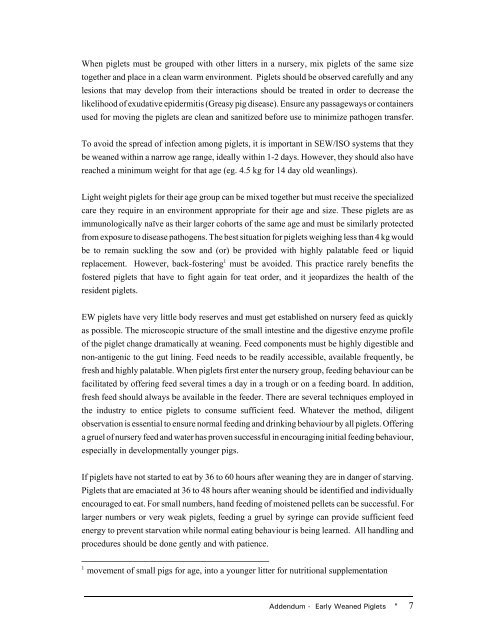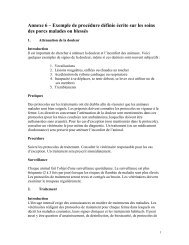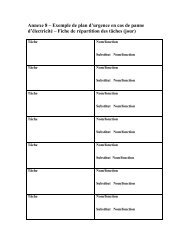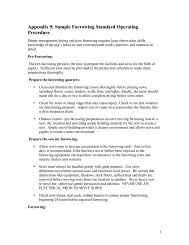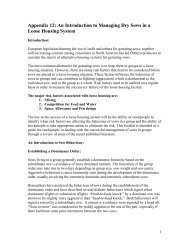Early Weaned Pigs - Carc-Crac.ca
Early Weaned Pigs - Carc-Crac.ca
Early Weaned Pigs - Carc-Crac.ca
You also want an ePaper? Increase the reach of your titles
YUMPU automatically turns print PDFs into web optimized ePapers that Google loves.
When piglets must be grouped with other litters in a nursery, mix piglets of the same size<br />
together and place in a clean warm environment. Piglets should be observed <strong>ca</strong>refully and any<br />
lesions that may develop from their interactions should be treated in order to decrease the<br />
likelihood of exudative epidermitis (Greasy pig disease). Ensure any passageways or containers<br />
used for moving the piglets are clean and sanitized before use to minimize pathogen transfer.<br />
To avoid the spread of infection among piglets, it is important in SEW/ISO systems that they<br />
be weaned within a narrow age range, ideally within 1-2 days. However, they should also have<br />
reached a minimum weight for that age (eg. 4.5 kg for 14 day old weanlings).<br />
Light weight piglets for their age group <strong>ca</strong>n be mixed together but must receive the specialized<br />
<strong>ca</strong>re they require in an environment appropriate for their age and size. These piglets are as<br />
immunologi<strong>ca</strong>lly naïve as their larger cohorts of the same age and must be similarly protected<br />
from exposure to disease pathogens. The best situation for piglets weighing less than 4 kg would<br />
be to remain suckling the sow and (or) be provided with highly palatable feed or liquid<br />
replacement. However, back-fostering 1 must be avoided. This practice rarely benefits the<br />
fostered piglets that have to fight again for teat order, and it jeopardizes the health of the<br />
resident piglets.<br />
EW piglets have very little body reserves and must get established on nursery feed as quickly<br />
as possible. The microscopic structure of the small intestine and the digestive enzyme profile<br />
of the piglet change dramati<strong>ca</strong>lly at weaning. Feed components must be highly digestible and<br />
non-antigenic to the gut lining. Feed needs to be readily accessible, available frequently, be<br />
fresh and highly palatable. When piglets first enter the nursery group, feeding behaviour <strong>ca</strong>n be<br />
facilitated by offering feed several times a day in a trough or on a feeding board. In addition,<br />
fresh feed should always be available in the feeder. There are several techniques employed in<br />
the industry to entice piglets to consume sufficient feed. Whatever the method, diligent<br />
observation is essential to ensure normal feeding and drinking behaviour by all piglets. Offering<br />
a gruel of nursery feed and water has proven successful in encouraging initial feeding behaviour,<br />
especially in developmentally younger pigs.<br />
If piglets have not started to eat by 36 to 60 hours after weaning they are in danger of starving.<br />
Piglets that are emaciated at 36 to 48 hours after weaning should be identified and individually<br />
encouraged to eat. For small numbers, hand feeding of moistened pellets <strong>ca</strong>n be successful. For<br />
larger numbers or very weak piglets, feeding a gruel by syringe <strong>ca</strong>n provide sufficient feed<br />
energy to prevent starvation while normal eating behaviour is being learned. All handling and<br />
procedures should be done gently and with patience.<br />
__________________________________________<br />
1<br />
movement of small pigs for age, into a younger litter for nutritional supplementation<br />
Addendum - <strong>Early</strong> <strong>Weaned</strong> Piglets " 7


